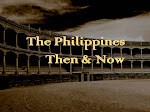REPUBLIC OF THE PHILIPPINES
GOVERNMENT
Present form of Government: DEMOCRATIC
The new Philippine Constitution was ratified in early 1987, signalling the country's return to democracy.
The country has three major branches. The EXECUTIVE, LEGISLATIVE and JUDICIAL BRANCH
Composed of Cabinet(with Cabinet members) and headed by a Chief of State.
The President is both the chief of state and head of government.
Cabinet Members are appointed by the President with the consent of the Comission on Appointments' elections: president and vice-president elected on separate tickets by popular vote for six-year terms; election last held 16 May 2004 (next elections to be held on May 2010).
LEGISLATIVE BRANCH:
Bicameral Congress or Kongreso consists of the Senate or Senado (24 seats: one-half elected every three years; members elected by popular vote to serve six-year terms) and the House of Representatives or Kapulungan Ng Mga Kinatawan (214 seats: members elected by popular vote to serve three-year terms. Additional members may be appointed by the President but the Constitution prohibits the House of Representatives from having more than 250 members) Elections: Senate - last held 16 May 2004 (next elections to be held on May 2010); House of Representatives - elections last held 16 May 2004 (next elections to be held on May 2010) .
JUDICIAL BRANCH:
Supreme Court (justices are appointed by the president on the recommendation of the Judicial and Bar Council and serve until 70 years of age).
Predominantly Christian.
Catholics - 82.9%
Protestants - 5.4%
Islam - 4.6%
Philippine Independent Church - 2.6%
Iglesia ni Cristo - 2.3%
Historically, the Filipinos have embraced two of the great religions of the world - Islam and Christianity. Islam was introduced during the 14th century shortly after the expansion of Arab commercial ventures in Southeast Asia. Today, it is limited to the southern region of the country.
Christianity was introduced as early as the 16th century with the coming of Ferdinand Magellan in 1521.
Protestantism was introduced by the first Presbyterian and Methodist missionaries who arrived with the American soldiers in 1899.
Two Filipino independent churches were organized at the turn of the century and are prominent today. These are the Aglipay (Philippine Independent Church) and the Iglesia Ni Kristo (Church of Christ) founded in 1902 and 1914, respectively. Recently, the Aglipay signed a covenant with the Anglican Church. The Iglesia ni Kristo has expanded its membership considerably. Its churches, with their unique towering architecture are landmarks in almost all important towns, provincial capitals and major cities.
ECONOMY AND LIVELIHOOD
Due to the combined effect of the Asian financial crisis and poor weather conditions, GDP growth in 1998 fell to about-0.5% from 5% in 1997, but recovered to about 3% in 1999 and 3.6% in 2000. Upon assuming office, President Arroyo and her Economic Team put in place an economic plan to ensure that the economy is on track for equitable development and sustainable growth. The Philippine Economic Plan comprises a comprehensive set of fiscal discipline measures and market reforms linked to clear targets. This plan recognizes that a stable macroeconomic environment is a pre-requisite to stimulating investment and sustainable growth. It integrates a well-coordinated set of strategic fiscal and monetary policy priorities that support a sound fiscal and debt position, low rates and inflation, and healthy current account levels. It also outlines guidelines related to good governance practices that ensure that reforms are effective and long lasting. From the first quarter of 2005 with a GDP of 4.2%, it ended the year 2006 with a GDP of 5.4%.
The fiesta is part and parcel of Filipino culture. Through good times and bad times, the fiesta must go on. Each city and barrio has at least one local festival of its own, usually on the feast of its patron saint, so that there is always a fiesta going on somewhere in the country. But the biggest and most elaborate festival of all is Christmas, a season celebrated with all the pomp and pageantry the fun-loving Filipino can manage.
The major cultural agencies of government are the Cultural Center of the Philippines, the National Historical Institute, the National Museum, The National Library, the Records Management and Archives Office, and the Commission on the Filipino Language. The Heads of these cultural agencies are all ex-officio members of the NCCA Board and all except the Commission on the Filipino Language are together under the National Commission on Culture and Arts.
TECHNOLOGIES AD INFRASTRUCTURE
For all of the countries that have already been in the Philippines, the countries nowadays have already been engaging into a lot of modern technologies to lessen up their work load. Such technologies include the Using of cars which from the old they used the calesas. The machines used for mining,cultivating and others to produce products to be distributed in all parts of the world. Modern phones upgraded from different features are presently using today like Nokia,Sony Erickson,Samsung and etc. As the inventors continually find ways to improve having more advance technologies, the more conviniece there is in the country.





is this post colonial?
ReplyDelete